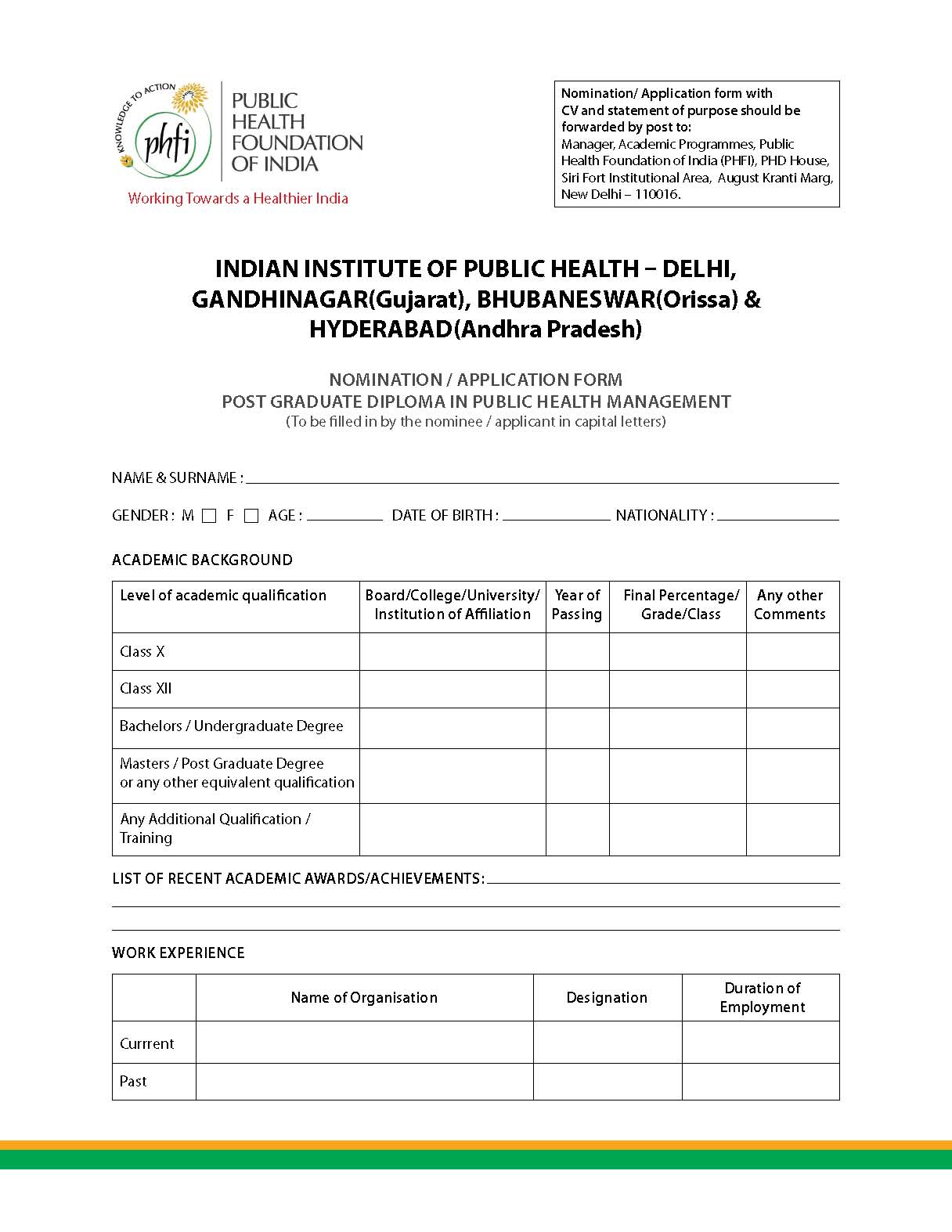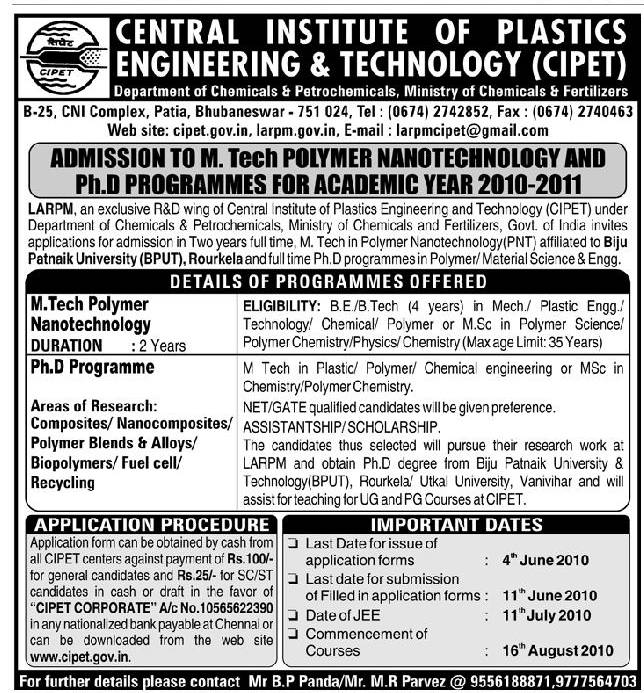Following is from a report in webnewswire.
Xavier Institute of Management-Bhubaneswar(XIMB) announces Financial Planning and Wealth Management Program in New Delhi, for graduates, working professionals and enterpreneurs providing services to financial sector and for those who hold keen interest in the same sphere. This program will expose the participants to various theories and practices of Financial and Wealth Management enabling them to equip with the techniques with which they can handle their current business tasks in better and effective manner.
Since, the prime objective of the program is quality education that would help in better career prospects in corporate sector, the core faculty of XIMB would hold the sessions at Lodhi Road imparting both practical and theoratical insights of the financial world. The lectures would be a judicious blend of physical classroom sessions, instructor lead training, quizzes, case studies and project works. Participants would be benefited both academically and professionally as this program would have a high market value and branding among the corporates.
During the total tenure of 6 months integrated approach to learn various aspects of Finance, Financial Services Insurance(Life, Non-Life), Risk Management, Pension Planning, Estate and Tax Planning would give participants holistic perspective of Financial Planning so that they can shoulder greater responsibilities in their future career. Details of the program is available on www.indialearn.com or www.alethia.in.
Eligibility of the program is minimum 50% in graduation. Participants can attend the lectures without compromising their working schedule. The admission process would include application form+written test followed by personal interview. Participants will be awarded with a certificate from XIMB after the completion of the program.
Total fee is of Rs.50,000+ service tax. The documents required for the admission are certified copy of official academic records, copy of work experience (with attached visiting card) and four passport size colour photographs.
Admission forms are available from Ms Darshana Vyas at darshana@creativecrest.com and these can be obtained free of cost.For further information call 011-46076571 or 9268730013.
I was told XIMB is also exploring offering short courses in Dubai. These initiatives should help further increase the brand value of XIMB. In addition extra money from these initiatives could be deployed in the proposed Xavier University and new XIMB campuses in Khurda and Balangir. Odisha government should fast track the Xavier University Bill and any issue (such as land allotment) associated with the new XIMB campuses.
June 25th, 2010
Following are excerpts from a report in sify.com.
- IIT Mandi: … nestled in the lowermost climatic zone of the serene Himalayas in Himachal Pradesh.The institute plans to involve its research scholars in teaching to enhance its faculty strength. It will launch doctoral programmes this August and plans to request the ministry to fund research scholars who will be involved with teaching at the institute."… At present, recruitment of full-time faculty is underway. Nine faculty members have accepted the offers. Additional 10-12 faculty members are expected to do so shortly. …" says S P Gupta … has received 513 acres of land for its main campus …
- IIT Hyderabad: … is banking on its faculty members to consolidate its research activities. According to U B Desai, director of IIT-H, faculty members have not only begun receiving research grants from DST, MCIT/DIT and other organisations, but have also begun publishing research papers in international journals. … 100 for M Tech programmes and 50 for PhD. Moreover, as against a full-time faculty strength of just over 40 last year, IIT-H is expecting the number to go up to 50 faculty members in its 10 departments. … "About 531 acres of land has been given by the state of Andhra Pradesh. While master planning of the new campus is done, we have called for expression of interest by architects. The new campus should be ready in about two years."
- IIT Indore: … expects its permanent campus to be ready by the end of 2011. "At present, the need for independent infrastructure, including lab facilities, is an issue. However, it does not imply that we will compromise on quality" … The institute does not plan to start the MTech programme at least for the next three years. As for faculty, the current capacity is 26 while the required capacity is 30 per year at all IITs.
- IIT Rajasthan: Apart from its B Tech programme getting its third batch since inception, IIT Rajasthan is also initiating PhD programmes for the first time from this year. Running from MBM Engineering College in Jodhpur, IIT Rajasthan has also been provided 300-odd PWD quarters for offering residential facilities to faculty members, staff and students alike. While IIT Rajasthan has been able to admit 120 students per batch so far, with its own campus coming up on a sprawling 900 acre land, the institute expects the numbers to rise.
- IIT Gandhinagar: … currently functioning from a makeshift campus at Vishwakarma Engineering College near Ahmedabad, saw the latter’s students protesting to shift the temporary campus of IIT-Gn from their college premises. The Gujarat government has now zeroed in on a 385-acre plot for the purpose of building the campus for IIT Gandhinagar.
- IIT Bhubaneswar: .. claims to be the first IIT out of the eight new IITs to be operating on its own infrastructure. "This is partially our own campus and we are the only IIT to be operating out of our own campus. Even after we move out to our permanent campus at Arugul, this building will continue to be our city centre. We have also selected project management consultants who will design our permanent campus and we expect the construction to begin by the end of this year and to be completed by 2014," says BK Rai, registrar at IIT Bhubaneswar. The institute has been allotted 936 acres of land by the Orissa government for its permanent campus designed to have a self contained campus for 10,000 students and 1100 faculty and an estimated amount of Rs 780 crore will be spent in next few years to develop this institute. A science park will be part of this institution. IIT Bhubaneswar will also the first IIT to set up a separate marine campus in 2011 for conducting interdisciplinary research in rising sea levels, ecology, disaster management, marine ecosystems, fishery development, and other areas.
- IIT Ropar: … has 10 PhD candidates at present and will add another 15 by January next year. IIT Ropar currently runs BTech and PhD courses. As it faces hostel accommodation constraints, the institute is "not ready" to start MTech courses in the immediate future. This year, 25 faculty members will be joining the institute by July adding strength to the institute which has 27 faculty members at present. …At present, the IIT is functioning from its Ropar-based transit campus, which was earlier The Polytechnic College for Women. The Government of Punjab has provided 500 acres of land near the banks of Sutlej river which is expected to be ready by the end of 2010 or beginning of 2013.
- IIT Patna: The institute has recruited 47 faculty so far and has 240 students including 11 PhD students till date. As it readies to welcome its third batch of students, IIT-P has new building ready on the premises of the New Government Polytechnic, from where the institute is currently functioning. As for the labs, IIT-P has hired the building of Software Technology Park of India (STPI), Patna.
The current faculty strength of IIT Bhubaneswar is 40. (It was 16 as per its webpage in October 24, 2009 and 37 on April 26, 2010.) I am not sure how many new ones are expected to join in Fall 2010. While browsing the websites of the various websites some things jumped out. (i) IIT Ropar has a large number of faculty with foreign Ph.Ds. (ii) IIT Hyderabad is recruiting faculty in departments other than basic sciences, Humanities and the three disciplines in which it offers B.Tech. It is offering M.Tech programs in these additional departments. (iii) IIT Patna has hired the maximum number of faculty (47) closely followed by IIT Hyderabad (45) and IIT Bhubaneswar (40).
June 21st, 2010
Following is an excerpt from a report in India Today.
… The Indian Institute of Mass Communication (IIMC) is all set to become a full-fledged university and will offer degree courses from next year.
Diploma students seeking admission in the current session are likely to have the option to continue the two-year post-graduate courses from next year. Interviews for the one-year courses will begin on Monday.
… The IIMC will offer two new two-year post-graduate diploma courses in development journalism, and corporate communication and media management.
The course material for turning the existing one-year diploma courses such as English journalism, advertising and electronic journalism into a two- year course has also been prepared.
To make the two-year advanced post-graduate diploma courses equivalent to an MA degree, the information and broadcasting ministry wrote to the HRD ministry.
… This will enable students to go into research while filling the gap of getting trained manpower in academics, teaching and the media industry.
Four new regional centres are also coming up in J&K, Mizoram, Maharashtra and Kerala. IIMC also has a centre at Dhenkanal in Orissa.
This would mean that the current combined student strength of 372 at Delhi and Dhenkanal would go up to 935 in the next few years with the addition of 200 students at the four new centres.
Soni asked the officials to not repeat the same courses in all IIMC branches. "For example, proposed IIMC Mizoram can have a course on animation, instead of repeating courses offered in Delhi," she said.
Adding graduate courses would cost the IIMC over Rs 45 crore. The minister asked officials to go liberal with funding to bring the institutions on a par with world class universities.
The Odisha government should pursue upgradation of IIMC Dehenkanal and make sure that it is not inferior to the new ones that are being made. In particular it should offer additional land and together with IIMC Dhenkanal officials make a plan of expansion and pursue it with the central minister of I & B Ms. Ambika Soni.
June 21st, 2010
Businessworld has an article on various management schools that are opening second campuses across the country. Among the seven institutes that are mentioned regarding second campuses, Bhubaneswar figures with respect to 4 of them. The article also updates on the status of these campuses. Following are some excerpts:
… International Management Institute (IMI) is also setting up a second campus in Bhubaneswar. The ostensible reason for a second campus is the shortage of infrastructure at the Delhi campus. “But the choice of location was based on the encouragement from the state government and our desire to bring high quality management education to this region,” says P.K. Bhaumik, director, IMI-Delhi.
… Xavier Institute of Management, Bhubaneswar (XIMB), has already been given land by the Orissa government for its second campus in Khurda (15 km from the main campus). “The government of Orissa had said they would build a compound wall to the Khurda campus and hand it over to us,” says P.T. Joseph, director, XIMB. The institute also plans to open two new campuses in Bolangir and Sambalpur in Orissa. However, the state government is yet to sign the Memorandum of Understanding for the other two plots.
Similarly, Birla Institute of Management Technology (Bimtech), has been granted 30 acres of land by the Orissa government to set up a new campus in Bhubaneswar. “So far, we have registered the new campus and are finalising the design. With two specialised programmes, Faculty of Management and Faculty of Design, the first session is expected to start in June 2012,” says Harivansh Chaturvedi, director of Bimtech.
…Institute of Chartered Financial Analysts of India (ICFAI University), which has eight campuses all over the country, is now adding new campuses in Ahmedabad, Jaipur, Baddi (Himachal Pradesh), Guwahati, Indore and Bhubaneswar. “This is not a new trend. For so long, the IIMs were at seven different locations and Xavier’s was at four different locations. Now, others are following,” says Koshy Verghese, secretary general, Federation of Universities, Hyderabad.
Does the above mean that BIMTech Bhubaneswar will have a program in Design.
June 21st, 2010
Following is from a report in tathya.in about the discussion of Xavier University in the Odisha Cabinet.
Ananga Udaya Singh Deo has favoured Xavier Institute of Management Bhubaneswar(XIMB) to set up Xavier University in the state.
Minister Planning & Coordination speaking in the State Cabinet on 9 June, said if any institution merits for a University status, it is XIMB.
Giving out details Minister said that XIMB is serving the State of Odisha since 1987 has more than 4000 alumni, out of whom more than two third are from Odisha.
Mr.Singh Deo said educational institutions with little known academic excellence are allowed to set up universities, where as proposal of XIMB for a University is pending for a long time.
Cabinet was given details on XIMB by Mr.Singh Deo as he said being a Jesuit Institution, XIMB can easily tie up with other Jesuit Universities from all across the world such as University of Santa Clara, Loyala Chicago, Georgetown, St.Louis and Marquette etc.
Speaking about the credibility of XIMB, he said that for 180 seats of PGDM, XIMB has attracted 20,000 applications.
He said that in 2010 it self 48 foreign students have expressed their desire to come and spend a semester at XIMB and by making it a University more foreign students will be attracted.
XIMB has collaborations with 12 international universities and more are in offing, revealed the Minister Planning & Coordination.
Pointing out about the cent per cent placements of its students and highest placement records in Odisha has proved the credentials of XIMB in the country, said he.
Involvement of XIMB in the development of most backward districts of Odisha in KBK, where it is planning to set up its second campus will go a long way if they are allowed to set up a University, added he.
So Mr.Singh Deo urged Minister Higher Education to place the Xavier University Bill for approval of the Cabinet as soon as possible for the best interest of the state.
Debi Prasad Mishra, Minister Higher Education sounded on a positive note.
Although it is good that Xavier University was discussed in the cabinet, it is really unfortunate that the bill was not brought to the cabinet, while bills corresponding to lesser institutions were brought to the cabinet.
Following is from another article in tathya.in.
Decision makers in Odisha have failed to visualize the implications of delaying the establishment of University of Xavier Institute, which is going to cost the state dearly, feel educationists and intelligentsia.
Xavier is a brand name well known in Odisha (through XIMB), India and abroad and educational institutions bearing the Xavier name are highly regarded in India and abroad.
While the State Government is sponsoring proposals of institutions little known for their academic excellence, they have all along ignored the proposal of Xavier Institute of Management Bhubaneswar (XIMB) for a univarsity.
Just for comparison purposes, there is no Sri Sri labeled educational institution that is in any rankings.
Similarly, there is no Vedanta named higher educational institution.
And last but not the least Krupaluji Maharaj has been given land to set up a University in Odisha!!!
The Jesuit Society of India has established the XIMB.
XIMB is a top management institute in India and ranked very highly and in fact, it is the highest ranking institute in Odisha in any field.
The next closest is NIT Rourkela which is ranked in the thirties among all engineering colleges/institutes.
In India: Besides XIMB, XLRI (Xavier Labor Research Institute, Jamshedpur) is a top 5-7 ranked management institute in the country.
Similarly, XISS (Xavier Institute of Social Services, Ranchi) is also a well-established name.
In addition there are many other Jesuit institutions that are well regarded in India.
This includes the various Loyola colleges.
In US: There are three Xavier Universities in USA in Cincinnati, Chicago and Louisiana.
In addition there are about 30 other Jesuit universities in the USA which include famous universities such as Georgetown University.
If a Xavier University is made in Odisha, it will be the first Xavier University in India.
The above facts make a Xavier University in Odisha very special.
By being the first Xavier University in India, it will have the first mover’s advantage.
By virtue of being the first Jesuit University in India, a Xavier University in Odisha will be in a position to get help from the 30 Jesuit Universities in US.
XIMB is ready to start construction that will make it a university, said sources.
XIMB had already planned for expansion and was ready to start construction for some time.
The XIMB Director Father P T Joseph has already received permission from the Jesuit society to set up Xavier University.
This has been also discussed in the recent board meeting of XIMB.
Several new programs that will be part of the university are already approved by the XIMB governing board.
Father Joseph, the Director of XIMB notices the lack of good arts and commerce programs in Odisha (the IIT, NISER, NLUO, XIMB, IIPH, AIIMS etc. take care of the engineering, science, law, business, public health and medicine areas) and would like the Xavier University to have top notch world class programs in arts and commerce.
The top ranked Arts and Commerce programs in the country include many other sister Jesuit institutions such as Loyola Colleges, St. Xavier’s colleges and St. Joseph’s colleges.
Despite all of the above, the Odisha Government is dilly-dallying in establishing the Xavier University in Odisha.
This is especially bad because a sister institution of Xavier, the Georgetown University of the US is interested in opening a branch in India.
If only the Odisha government had established Xavier University, it could have approached Georgetown to open its branch in Bhubaneswar.
Because of the lack of foresight of Odisha, the state may not only remain backward in arts and commerce programs, but it may also lose the chance to get a branch of the famous Georgetown University to Odisha.
June 9th, 2010
See details at http://application.nitrkl.ac.in/ and http://www.nitrkl.ac.in/admission_docs/Extension%20of%20dates_6_1.pdf. Following is an ad about this that appeared in some newspapers today.
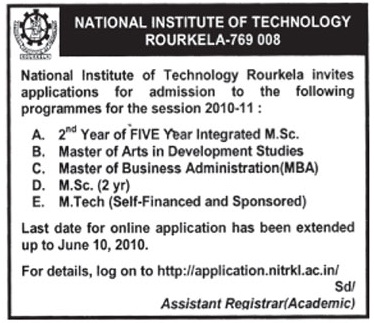
It is great to see that NIT Rourkela is offering MBA and 2 yr and 5 yr M.Sc programs. Also impressive is its offering of programs in Life Sciences and Biotechnology and Medical Engineering.
In the future it should aim for a program in Intellectual Property Law (as is offered in IIT Kharagpur), more programs in liberal arts (such as in Economics), and possibly even an MBBS in collaboration with one of the local hospitals.
VSSUT Burla should follow NIT Rourkela’s path in expanding its offerings.
June 4th, 2010
Update:The expanded ads are now in the NISER web site. See the links below.
One thing to note is that NISER is likely to implement the PRIS (Performance related incentive scheme) of DAE under which there is provision for monthly incentive of 20% of basic salary. This is already implemented in some DAE institutions. See for example http://www.saha.ac.in/cs/adm.cs/ADM/PRIS.pdf.

The expanded version of this ad is not yet in NISER website. The ad from last year is at http://niser.ac.in/notices/2009/new-faculty.php and gives an idea of how much the initial salaries will be. following is an excerpt.
ASST. PROFESSOR : Pay Band Rs 15,600 – 39,100 + Grade Pay 7,600
Basic pay on initial appointment will be Rs 29,920 + 22% D.A at current rates + 20% HRA on basic pay. Total emoluments will be approximately Rs 44,438/- per month.
READER (F) – Pay Band Rs 37,400 – 67,000 + Grade Pay 8,700
Basic pay on initial appointment will be Rs 46,100 + 22% DA at current rates + 20% HRA on basic pay. Total emoluments will be approximately Rs 67,414/- per month.
Currently NISER has the following numbers of faculty in the various disciplines:
This adds up to a total of 37 permanent and 21 visiting faculty.
As a comparison IIT Bhubaneswar currently has 37 permanent faculty and 4 visiting faculty with the following break-up.
June 1st, 2010
Update: The press release corresponding to the ad below is now available at http://www.mohfw.nic.in/31Press%20relaease.doc. It does not have any additional info though.
The advertisement below appeared in various newspapers today. Although the ad mentions that more details are in the http://www.mohfw.nic.in/ site, nothing is there yet. (It may take a few days for more details to appear there.)
A similar tender invitation was issued in November 2009. See https://www.orissalinks.com/archives/3610 and https://www.orissalinks.com/archives/3408. Earlier in May 2008, tenders were floated for the housing complex. See https://www.orissalinks.com/archives/1121. (Even older links related to tenders for the AIIMS-like institution in Bhubaneswar are at https://www.orissalinks.com/?p=970.)
The PIB release http://pib.nic.in/release/release.asp?relid=59071 (see also https://www.orissalinks.com/archives/3962) gives the status of the construction of residential complex until March 2010.

May 30th, 2010
Prof. Jalote is the Director of IIIT Delhi and is on leave from IIT Delhi. Previously he taught at IIT Kanpur and University of Maryland. Prof. Singh is a professor at Auburn University, Alabama. Both are alumni of IITs. Following are excerpts from their article in Economic Times.
… The difficulty of cracking these tests have led to the booming coaching industry — it seems the vast majority of students appearing in these exams undergo some form of coaching for them. This impact of coaching has been decried by many. In academic circles, it is a common complain that coaching is allowing even average students to crack the exams, and how exams ought to be changed so that deserving students can clear even without coaching.
It should be clearly understood that the success of coaching is not due to the nature of the exams, but due to the low acceptance ratio in these exams. With these low accept rates, it is irrelevant whether the nature of exam is such that coaching will help or not.
… Anybody who thinks that coaching can be made redundant by reforming the admission tests is living in a state of denial.
There is another aspect of coaching that deserves attention. Coaching is big business: by some accounts, coaching for IITs is bigger than IITs themselves in terms of turnover. Consequently, it is able to attract good teachers by offering high salaries. One hears about IIT/IIM grads teaching in these coaching institutes, but one cannot come across an IIT/IIM graduate as a teacher in a school — even elite schools do not have this distinction. So, in many coaching centres, the quality of education is superior to that of schools, particularly with respect to the entrance test subjects. As the business success depends on how well they help the students do in the entrance exams, their teaching, as measured with respect to success in these exams, continues to improve and they take great care to improve it.
So, we have the following situation. Coaching institutes will continue to thrive as long as the accept ratio remains small. And coaching business will ensure that its teachers and teaching processes are well-equipped to impart training to students to do better at the competitive exam.
This situation, undesirable thought it is, can, however, be converted into an opportunity to improve education. As coaching institutes focus on the entrance tests and the syllabus for them, it provides a power to these exams in that whatever they put as syllabus or as expected knowledge, the coaching institutes will ensure that students get good at that. Even for those students who do not undergo coaching, these exams are highly influential — students learn/ study for these exams with a mission and dedication that they don’t show for anything else.
IF THESE large exams were to be oriented such that preparation for them will make the foundations for the key subjects much stronger and will force the students to really understand the subjects better, the coaching industry will ensure that this knowledge is imparted to students. That is, the syllabus and expectation is potentially a strong force on what students learn in the 2-3 years they prepare for the entrance exams, through coaching or on their own.
If this learning can be strengthened, then even if the students do not get through in these exams — which the vast majority will not — the preparation for them will give them strong foundations in some key subjects. This can be leveraged by other institutions.
… So, instead of fighting coaching by making exams like JEE harder and more theoretical every year, such large exams can leverage the competition for the larger good of improving the education and preparedness of students.
If these exams are thought of as a potential tool in the armory of the country for fighting the poor education standards, rather than just for admitting students into these institutes, then they can favourably impact the lakhs of students who attend JEE, and not just of the selected few thousands who actually enter the IITs, whose skills will be upgraded anyway to top levels by the top quality education that they will be provided. By doing so, institutions like the IITs and the entrance exams they have, will be making a solid contribution to improving the workforce in the country , as they have done in creating the top-level manpower.
I agree with the main point in the above mentioned article. Earlier I wrote my views on coaching at https://www.orissalinks.com/archives/4178.
However, there is an issue with respect to many students not being able to afford coaching. Couple of things that the governments may do are:
- Provide coaching in some government schools such as Navodaya Vidyalayas.
- Provide other avenues for good coaching such as attempts to replicate the Super 30 in Bihar by other governments.
- Bring coaching classes and the +2 level under the ambit of RTE and require that certain percentage of the students there are from poorer background.
- Provide scholarships to poor students to be able to afford good coaching.
May 16th, 2010
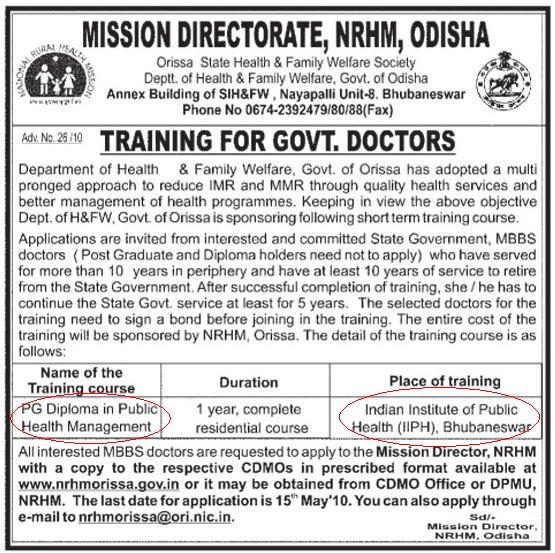
Note that currently this program (PG Diploma in Public Health Management) is not offered by AIPH Bhubaneswar. Currently AIPH offers a certificate in Public Health Management, PG Diploma in Public Health Informatics and MPH (in collaboration with Ravenshaw University).
May 4th, 2010
Following is an excerpt from a report by Kalpana Pathak in sify.com.
The Ministry of Human Resource Development (MHRD) may soon introduce a Bill in Parliament to facilitate the establishment of 20 Indian Institutes of Information Technology (IIITs) under the public-private-partnership (PPP) model.
… The IIITs will offer under-graduate, masters and PhD programmes. Each institute will have an intake capacity of about 1,000 students within a period of six to seven years of their functioning.
"The IIITs will be governed by an Act to be modelled on the lines of the Indian Institutes of Technology (IIT) Act. These institutes will enjoy autonomy and also have the power to frame their own ordinances and statutes," said the director of an existing IIIT in the north. The IIITs, till date, have been functioning as bodies registered under the Society Registration Act and therefore governed by its regulations and by-laws, he explained.
The PPP model, as envisaged by the HRD Ministry, entails that each Indian Institutes of Information Technology (IIITs) would be set up at an investment of Rs 200 crore. Of this amount, 85 per cent will be borne by the Centre (50 per cent or Rs 100 crore) and state governments (35 per cent or Rs 70 crore). The remaining 15 per cent (Rs 30 crore) would be invested by the IT industry.
Land for the institutes will be provided by the states, for a completely integrated campus with science and technology parks. Each institute will specialise on specific area of Information Technology. Each IIIT will be a centre of excellence in that domain.
… "The Planning Commission has given an in-principle approval for this. We are, however, waiting for a nod from the Expenditure Finance Committee (EFC) after which it would be moved to the aCabinet for final nod,” the director added.
May 3rd, 2010
Sources suggest that the Xavier University Bill is getting finalized and may be introduced in the Odisha assembly in the upcoming assembly session. There is plan that the proposed Xavier University (which will be established by the XIMB people) will have undergraduate programs including in Arts and Commerce.
This would be a Godsend. While Odisha now has top notch programs in Engineering (at IIT, NIT, VSSUT, CIPET), Science (NISER), Law (NLUO), Business (XIMB), Social Work (NISWASS), Public Health (AIPH, and soon IIPH) and Education (RIE), and soon will have a top notch program in fashion design (NIFT) and medicine (AIIMS-like Institute), it does not have top programs in Commerce and Arts. Thus the proposed Xavier University offering these programs will fill a huge lacuna. There are several reasons I believe that the Arts and Commerce programs at the proposed Xavier University will be top notch.
- They have track record in Odisha and India. Their XIMB is among the top ranked business schools in the country.
- The top ranked Arts and Commerce programs in the country include many other sister Jesuit institutions such as Loyola Colleges, St. Xavier’s colleges and St. Joseph’s colleges.
- Xavier University being a university will be able to modernize and revise its programs at will and thus will have advantage over other colleges that need to work with their universities. (Some of the top ranked colleges are now autonomous though.)
- Many of the other top ranked colleges are uni-disciplinary. Xavier University will be able to share faculty among multiple programs and thus able to create more multi-dimensional programs.
The proposed Xavier University offering top notch arts and commerce programs would help the other institutions to improve their arts and commerce programs and may even encourage other groups (such as KIIT and ITER) to establish good programs in Arts and commerce.
Thus the Odisha government should not delay and speed up the creation of Xavier University.
Following is from India Today’s 2009 list of top ranked Arts and Commerce programs in India.
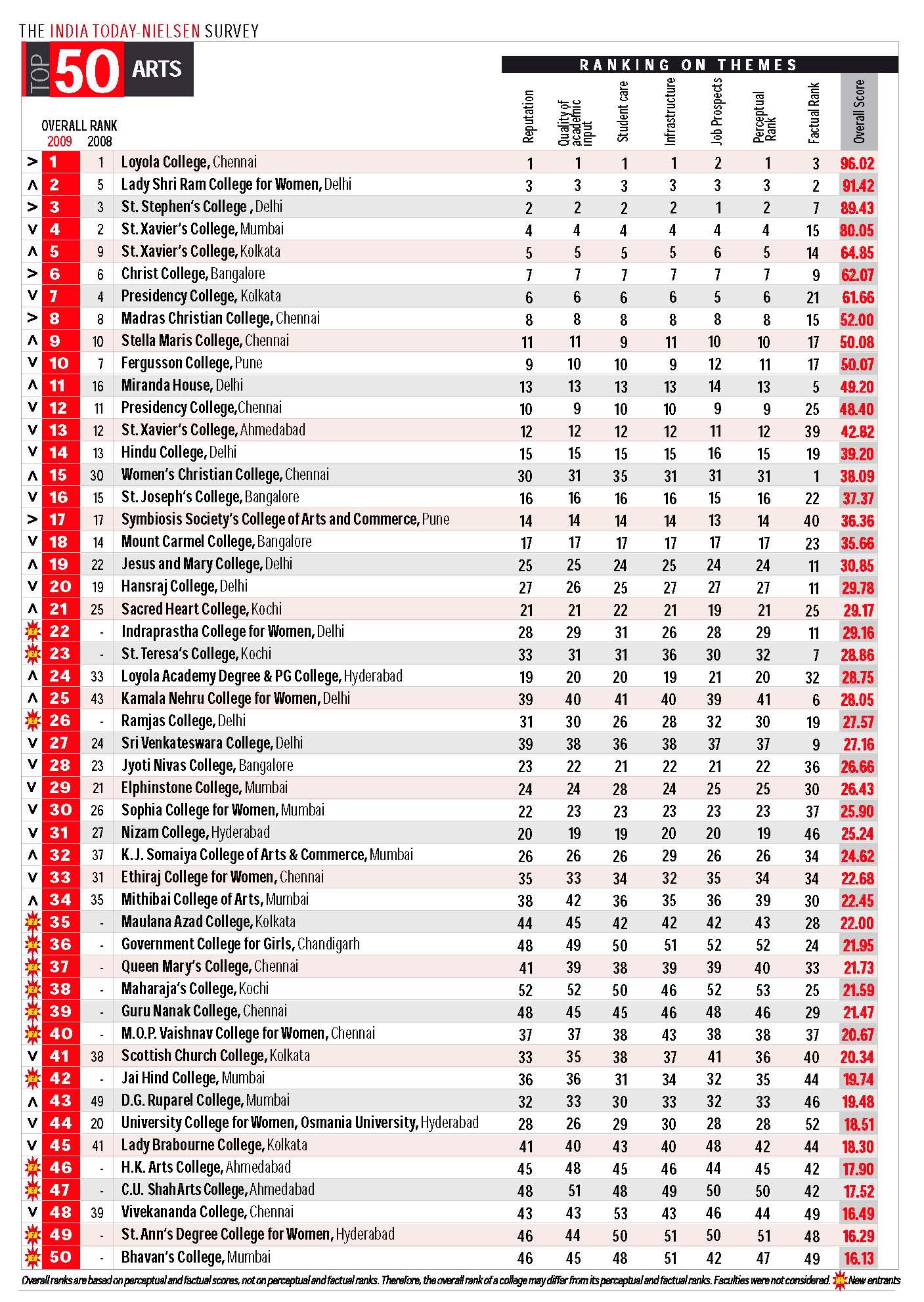
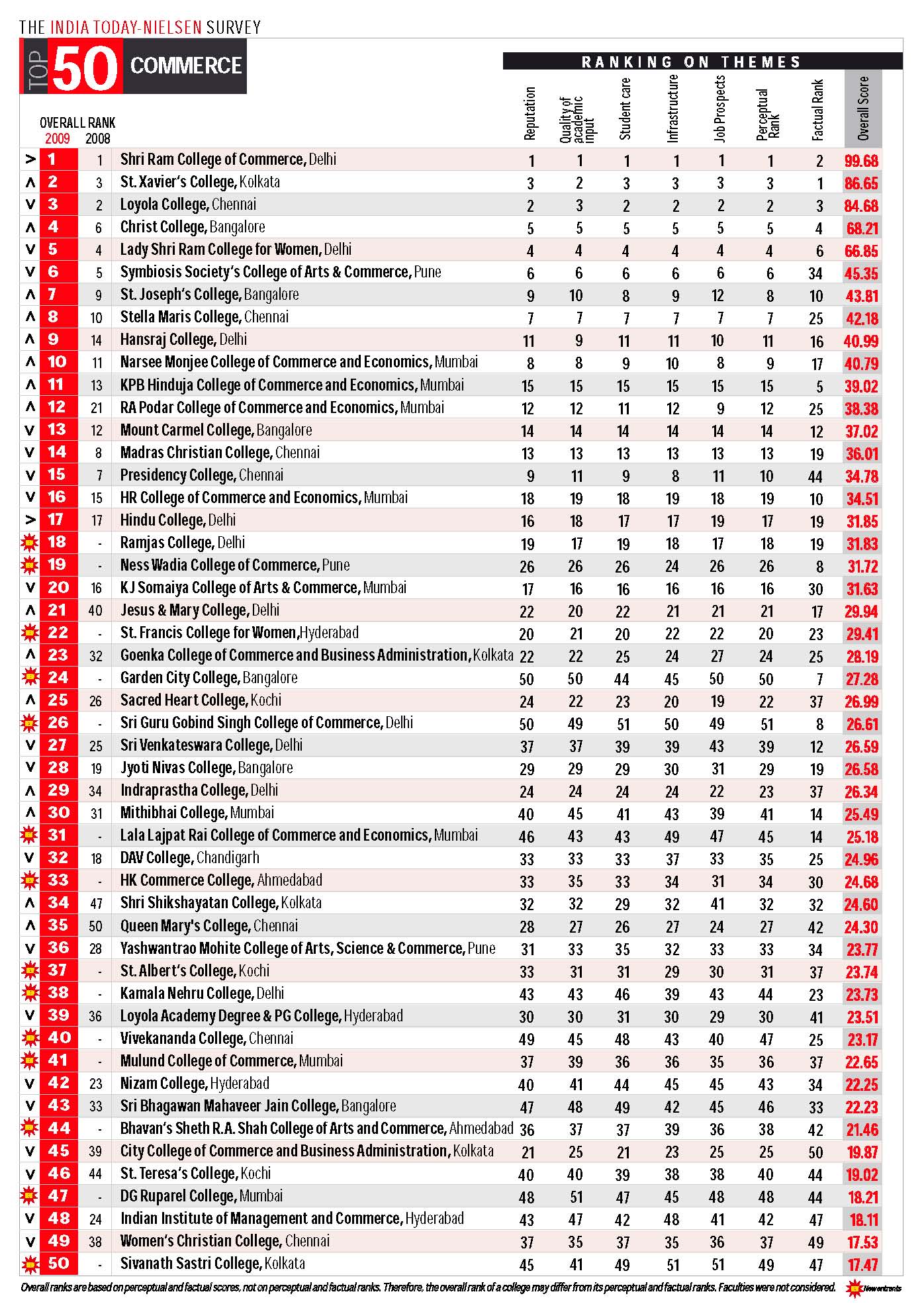
May 2nd, 2010



